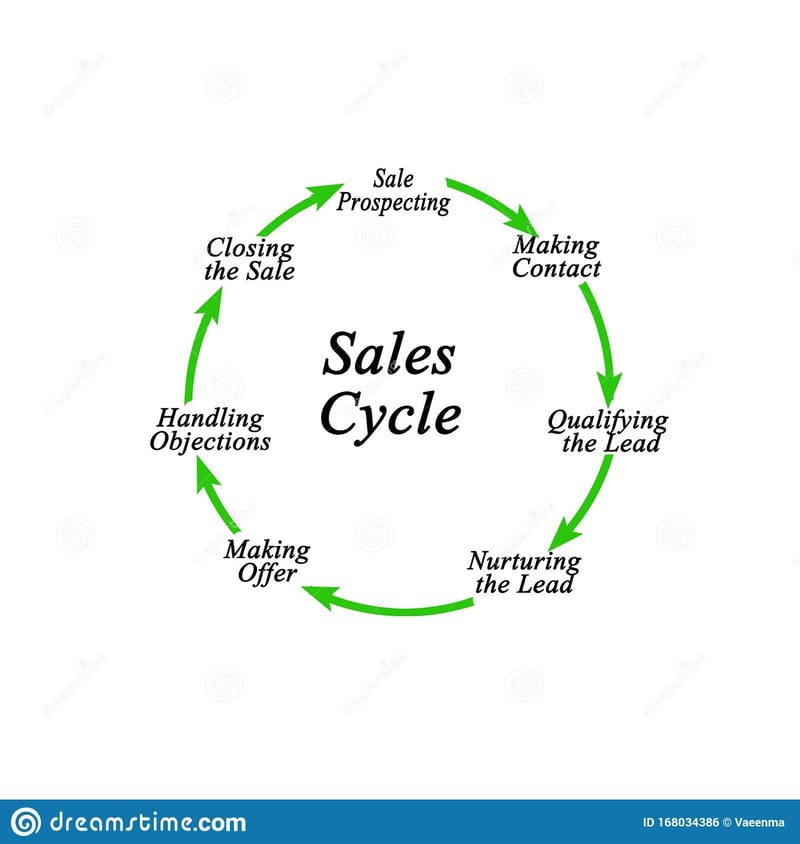
Saas Sales Cycle: A Detailed Overview
 Updated on
Updated on
 By Carlos Correa
By Carlos Correa
Carlos Correa
Carlos has been involved in the sales space for well over ten years. He began in the insurance space as an individual sales agent, managing teams as s...
learn more
Carlos Correa
Carlos has been involved in the sales space for well over ten years. He began in the insurance space as an individual sales agent, managing teams as s...
Table of Contents
Table of Contents
You can't "just wing" SaaS sales.
Even if you have plenty of traditional sales experience.
Because, within a SaaS sales cycle, customer lifetime value (CLV) and potential churn rates are as important – if not more important – than closing a sale.
After all, SaaS isn't about selling to customers once. It's about making sure they purchase an ongoing subscription and stick around with your company for the long term.
This means that you, as the SaaS salesperson, need to:
- Find the right leads
- Make a connection
- Educate prospects about a complex product
- Show them how it resolves their issues via a demo or a trial
- Convince them to make an ongoing commitment
- Check-in to make sure they're happy (and potentially upsell and cross-sell)
But don't get discouraged – all you need to succeed (apart from a can-do attitude) is a better understanding of the SaaS sales cycle.
And we're here to help.
So keep scrolling, and we'll equip you with the knowledge you need to become the Michael Scott Dwight Schrute of SaaS sales!
What Is a SaaS Sales Cycle?
A SaaS sales cycle is the visual representation of the stages that, as a whole, form the entire process of selling web-based software. In essence, this framework shows you all the different steps a person – in B2C sales – or a company – in B2B sales – takes on their journey from a lead to a loyal customer.
SaaS sales cycles are framed from the perspective of the sales agent (what the salesperson needs to do), and they help you better understand and track your prospects' buying process.
This methodological approach enables you to map your actions back to what your customers need at a specific moment in time, leading to an optimized sales process and a high-performing outreach strategy.
But how is a SaaS sales cycle different from a traditional sales cycle?
We alluded to it in the introduction, but here's our complete answer:
- You're selling Software-as-a-Service – an intangible, complex web-based application
- It's a long and winding process with many touch points, in which you're as much an educator as a salesperson
- You need to personalize the solution to your client's needs, i.e., an insurance salesperson will have different CRM needs compared to a construction company
- You're gunning for a long-term commitment from the client
- Upselling and cross-selling are just as important as winning new customers
This is what the typical SaaS cycle looks like (and notice how the last stage is "nurture" and not "close"):

Let's explain these seven stages in a quick table:
The SaaS Sales Cycle Stages
|
SaaS sales cycle stage |
Brief explanation |
|
Find leads |
Engage in lead generation activities (i.e., research or content marketing) to create a database of contacts potentially interested in your solution |
|
Connect |
Reach out to your leads Pro tip: use a lead information system to prioritize those with the highest lead score |
|
Qualify leads |
Evaluate if your leads are a good fit – ensuring you don't waste time and resources |
|
Present your solution |
Show your qualified prospect the value of your SaaS app Pro tip: make sure to personalize your demos and presentations |
|
Overcome objections |
Use your sales skills and your company's playbook to confidently answer your prospect's questions and move closer to a sale |
|
Close the deal |
Nurture your prospect until they're ready to sign a contract and get started with your web-based software |
|
Nurture new customers |
Don't stop after you've dotted the i's and crossed the t's on the contract – check in with your new customers and make sure they're getting the most out of your solution Pro tip: identify potential upselling and cross-selling opportunities |
Quick digression – if you're looking for actionable tips on how to excel at each stage, bookmark this blog post and return to it after you've finished this post.
Now back to our discussion of SaaS sales cycles:
The 3 SaaS Sales Cycle Models

You have a choice between three major SaaS sales cycle models:
- Self-service
- Transactional
- Enterprise
And there's no "right one." It all depends on the nature of your SaaS solution.
Let's briefly check them out.
1. Self-service sales model
This product-led approach relies on marketing efforts to drive traffic to your sales pipeline.
Or in other words, you won't be proactively selling.
Many B2C SaaS brands (like Spotify) use a freemium model to attract customers. They rely on users signing up and upgrading by themselves via an online onboarding process.
This model is ideal for simple, lower-priced, high-volume SaaS apps that can leverage a fully automated funnel.
2. Transactional sales model
Most B2B SaaS companies follow this sales-led approach (even us!).
This model uses a mixture of sales reps and content marketing to nurture leads as they progress through the sales cycle.
Human interaction is required because customers gradually become less willing to purchase through an automated funnel as prices increase.
They want to experience your company before deciding to sign up – and you need to demonstrate that:
- You care about customers
- You're willing to offer personalized service
- You're committed to a long-term relationship
3. Enterprise sales model
This last model is generally reserved for high-ticket, specialized software aimed at enterprises (hence, the name).
Think Oracle and Microsoft.
All the sales techniques you follow need to focus on breaking through the various levels of bureaucracy and reaching the final decision-makers.
This means this model comes with long sales cycles and many stakeholders.
Your sales reps and their extensive product knowledge are crucial to success.
Alright, so now you know what a SaaS cycle is and the three major models, we can:
- Tackle one of the most commonly asked questions we hear from salespeople new to the world of Software-as-a-Service
- Show you how to improve your SaaS sales cycle
Onwards and upwards.
How Long Is a SaaS Sales Cycle?

According to research by Hubspot, the average SaaS software sales cycle is 84 days long. However, the average length changes if we take annual contract value (ACV) into account, becoming 40 days long if the ACV is less than $5K (or $416 a month) or 170 days long if the ACV is more than $100K (or $8333 a month).
Quite a difference, right?
And price is only one of the five factors influencing the length of a software sales life cycle…
This means the more honest answer is, "SaaS sales cycles usually last for multiple months, but it's different for every company."
To help you determine your sales cycle's ideal length, we'll break down the five influencing factors to consider.
Factors that affect the length of a SaaS sales cycle
The SaaS sales cycle, like other software sales cycles, can vary depending on several factors. Here's a quick rundown:
- Price: Higher price points generally mean longer sales cycles due to larger budget commitments and more decision-makers involved.
- Customer Type: Consumer-focused products tend to have shorter cycles with single-person decisions. Small businesses may take slightly longer, while enterprise sales cycles are lengthy with complex approval processes.
- Product Complexity: Complex SaaS applications require more time to educate and convince potential customers.
- Trial Periods: Free trials add time to the sales cycle, but their length should be optimized based on your goals (e.g., conversion rate).
- Market Experience: Entering a new market means a longer sales cycle until you establish brand recognition.
5 Tips For Improving Your Own Software Sales Cycle
A lengthy SaaS sales cycle can strain your resources. Here are five key strategies to streamline your process and close deals faster:
|
Tips |
Description |
|
Qualify Leads Early |
Prioritize high-potential leads. |
|
Value-Driven Demos |
Speeds qualified leads towards buying decision. |
|
Optimize Free Trial Length |
Find the sweet spot for value & trial duration. |
|
Continuously Improve Your Sales Process |
Identify & address bottlenecks. |
|
Leverage Customer Advocacy |
Social proof pre-qualifies leads through customer referrals and testimonials. |
1. Qualify Your Leads
Every lead is unique. Invest time in qualifying leads to ensure they're a good fit for your product. This can involve lead scoring based on demographics, firmographics (company size, industry), and online behavior.
By prioritizing qualified leads, your sales team focuses their efforts on prospects with a higher chance of converting, shortening the overall sales cycle for your SaaS product.
2. Focus on Value in Your Demos
Don't just showcase features in your demos. Tailor them to address the prospect's specific pain points and demonstrate how your SaaS solution directly solves their problems. Quantify the value proposition with data and case studies whenever possible.
Focus on the return on investment (ROI) your software delivers, making it a clear decision for the prospect. This targeted approach shortens the sales cycle by eliminating demos that aren't a good fit and propelling qualified leads toward a buying decision.
3. Keep Free Trials Short
Free trials are a double-edged sword. They allow prospects to experience your SaaS product firsthand, but they also extend the sales cycle. Find the sweet spot between showcasing value and keeping the trial period concise.
Analyze your conversion rates during different trial lengths to determine the optimal timeframe. A shorter trial, strategically timed after a value-driven demo, can nudge qualified leads towards a purchase decision faster, ultimately shortening your sales cycle.
4. Continually Optimize Your Sales Process
The SaaS landscape is constantly evolving. Regularly evaluate your sales process to identify bottlenecks and areas for improvement. Analyze win/loss data to understand why some deals close quickly while others stall. Use customer feedback to refine your sales pitch and identify new qualifying criteria.
By continuously optimizing your SaaS sales cycle, you can identify and address inefficiencies that slow down the process, leading to faster conversions.
5. Get Referrals From Happy Customers
Happy customers are your strongest asset. Encourage satisfied users to provide referrals and testimonials. Social proof, in the form of positive customer reviews and case studies, builds trust with potential buyers and shortens the sales cycle.
By leveraging your existing customer base, you can pre-qualify leads who are already familiar with the value your SaaS solution offers, expediting the path to a closed deal.
Master the Art of the SaaS Sales Cycle

In SaaS sales, practice makes perfect.
So don't just leave our nine tips as words on a webpage – put them into action by reviewing your current sales cycle and determining where you can improve!
And, if along the way, you decide you need better sales tools to help you achieve your goals, don't hesitate to reach out and request a demo of Ringy.
We'll be more than happy to show you how an all-in-one sales CRM can help your SaaS business have better conversations with your prospects and customers at every stage of the SaaS sales cycle.

Skyrocket your sales with the CRM that does it all.
Calling? Check. SMS? Check. Automation and AI? Check. Effortlessly keep in touch with your customers and boost your revenue without limits.

Take your sales to new heights with Ringy.
Sales in a slump? Ringy gives you the tools and flexibility you need to capture leads, engage with them, and turn them into customers.
Subscribe to Our Blog
Enter your email to get the latest updates sent straight to your inbox!

